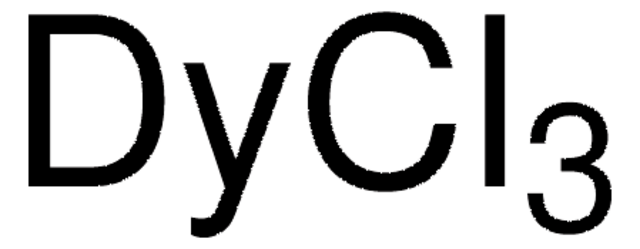261076
Dysprosium
ingot, 99.9% trace rare earth metals basis
About This Item
Prodotti consigliati
Saggio
99.9% trace rare earth metals basis
Forma fisica
ingot
Impiego in reazioni chimiche
reagent type: catalyst
core: dysprosium
Resistività
89 μΩ-cm, 20°C
P. eboll.
2567 °C (lit.)
Punto di fusione
1412 °C (lit.)
Densità
8.559 g/mL at 25 °C (lit.)
Stringa SMILE
[Dy]
InChI
1S/Dy
KBQHZAAAGSGFKK-UHFFFAOYSA-N
Cerchi prodotti simili? Visita Guida al confronto tra prodotti
Categorie correlate
Codice della classe di stoccaggio
11 - Combustible Solids
Classe di pericolosità dell'acqua (WGK)
WGK 3
Punto d’infiammabilità (°F)
Not applicable
Punto d’infiammabilità (°C)
Not applicable
Dispositivi di protezione individuale
Eyeshields, Gloves, type P3 (EN 143) respirator cartridges
Certificati d'analisi (COA)
Cerca il Certificati d'analisi (COA) digitando il numero di lotto/batch corrispondente. I numeri di lotto o di batch sono stampati sull'etichetta dei prodotti dopo la parola ‘Lotto’ o ‘Batch’.
Possiedi già questo prodotto?
I documenti relativi ai prodotti acquistati recentemente sono disponibili nell’Archivio dei documenti.
Articoli
Today, near-room-temperature refrigeration is almost entirely based on a vapor-compression refrigeration cycle.
A significant limiting factor for wearable electronics and wireless sensors is the finite amount of energy that can be stored in on-board batteries.
Rechargeable solid-state batteries are becoming increasingly important due to wide-spread use in computers, portable electronics, and vehicular applications.
Il team dei nostri ricercatori vanta grande esperienza in tutte le aree della ricerca quali Life Science, scienza dei materiali, sintesi chimica, cromatografia, discipline analitiche, ecc..
Contatta l'Assistenza Tecnica.






